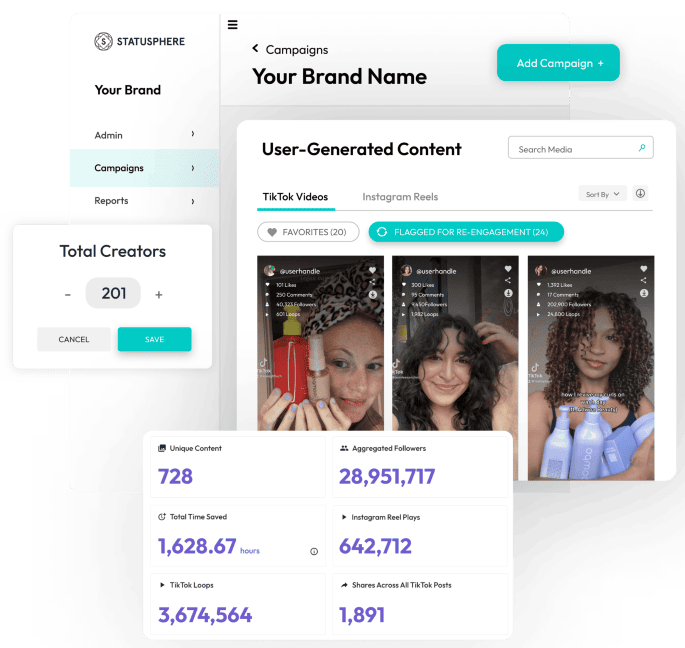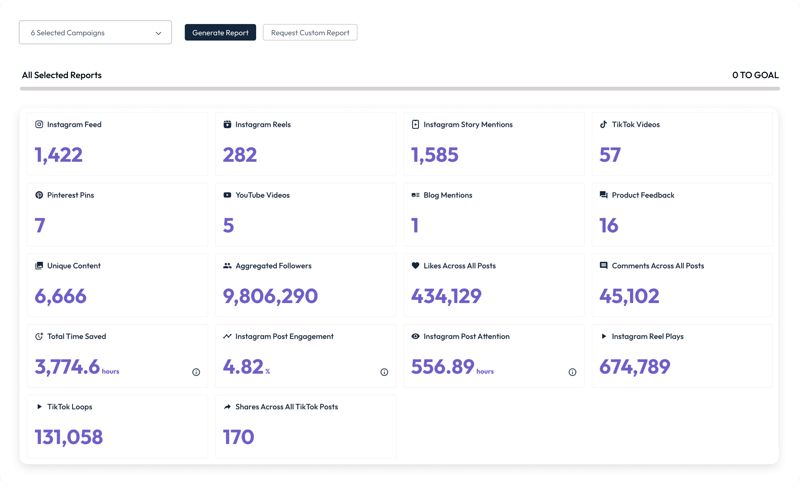What to Include in an Influencer Gifting Note (Examples + Samples)
Gifting notes add a personal touch to your brand's influencer packages. Here's how to write your own influencer gifting note plus examples to inspire...
Trying to pick the best influencer platform for your brand? You should be confident about your choice! Below we break down what key features to look for.


For busy consumer brands, investing in an influencer platform is pretty much inevitable.
But with 10,000+ martech tools in the wild, choosing the "best" software for anything is daunting.
This is especially true for influencer marketing platforms and tools.
Why? Because the creator space is always evolving. Not to mention getting more competitive.
And so the tools you rely on to run your campaigns need the right features so you can scale.
We encourage brands to put potential influencer platforms under the microscope before picking. This post can help as we break down...
Skip to Section 👇What to Consider When Picking the Best Influencer Platform for Your Brand
What Features Do the Best Influencer Marketing Platforms Have in Common? |
Remember: choosing the “right” tool depends on your brand's situation.
That’s why it’s so important to do your homework. Many platforms present themselves as one-size-fits-all. Chances are your needs are anything but, right?
We'll cover two types of influencer marketing platforms: self-service and scalable.
Self-service influencer marketing platforms help brands coordinate campaigns themselves. These tools include databases, CRMs and influencer marketplaces.
Scalable influencer marketing platforms (like Statusphere!) programmatically match brands with creators and execute campaigns from A to Z.
To hone in on which type of influencer tool is right for you, start with the seven questions below.
“Oh yeah, we can totally handle that ourselves.”
We've heard that one before.
And we get it! Marketers end up multi-tasking and wearing a lot of hats in any given role.
However, working with creators is a time commitment. A pretty serious one, too.
We always urge brands to be honest with themselves when it comes to their schedules. Like SEO or list-building, influencers are an investment that drives results over time. Brands that benefit most from influencers understand they’re playing the long game.
If you’re going to invest in influencer marketing, you should do it right! That means giving your creators and campaigns the attention they deserve.
Brands often underestimate the legwork required to research and contact creators.
Scrolling through social feeds. Drafting and responding to outreach emails. Negotiating.
That doesn’t scratch the surface of your most time-consuming campaign tasks, either.
Brands on a time crunch have the most to gain from a scalable influencer marketing platform. Taking a hands-off approach frees up your schedule. This gives you plenty of time to track your campaign progress without doing all the work yourself.
More brands today are bringing on full-time influencer specialists to take the reins.
Makes sense! Influencer marketing campaign management is a full-time job for many brands. This is especially true when you’re doing everything in-house, including:
Some self-service influencer management platforms provide a place for you to consolidate some of these tasks. For example, they might offer an inbox or dashboard to manage your campaigns.
A scalable platform takes all of the above off of your hands. That said, you're still in the loop on your campaign’s status and can make adjustments if needed.

Again, brands need to maintain realistic expectations when it comes to their campaigns.
It’s easy to dismiss the work required to hire creators at scale. That is, until you do it yourself.
First-timers can benefit from both types of influencer platforms.
Self-service influencer discovery tools can streamline your search process. A CRM or database might be overkill if you only end up working with a handful of creators, though. These tools can be overwhelming to first-timers.
If you have a campaign vision in mind but are struggling to execute it, a scalable platform is ideal.
For example, let’s say you want a specific number of creator posts of a certain style. Maybe vegan women in their twenties or millennial moms with newborns.
A scalable platform manages the creative direction of your campaigns and guarantees content from relevant creators. Contrast this with a discovery tool where how much content you earn depends on your success in identifying and pitching influencers.
Many brands try a DIY approach to influencer marketing and realize they’re in over their heads.
A self-service platform can help you uncover relevant creators, assuming you know what you want. Not 100% confident about what your campaigns should look like? A scalable platform can read between the lines, considering your goals to match you with creators and build a campaign around the information you've provided.
Let’s say you’re ready to scale your influencer campaigns. You’re committed and ready to go.
Nice! If what you’ve done has worked on a small scale, ramping things up makes sense.
How you go about it really depends on your team, schedule and budget. Do you want to manage all the elements at a larger scale or run a fully optimized campaign out of the box?
There is no right answer here. If you’ve been underwhelmed by an agency or platform in the past, a scalable solution could be a better fit.
Audience size is a big deal to brands and rightfully so.
Based on the types of influencers you want to work with, some platforms are better than others.
Let’s say you’re a boutique brand working with a handful of smaller, specialty creators. Are there platforms out there for you? Absolutely!
Thing is, your platform of choice might not meet the needs of an ecommerce company hiring hundreds of micro-influencers.
Micro-influencers are notable for their high engagement rates and level of authenticity. This results in meaningful interactions among their followers.
Micro-influencers resemble everyday consumers because they are everyday consumers. These creators are actively building loyal, trusting communities. Their authenticity is their superpower. This applies to the power-middle influencers we’ve partnered with, too.
Consider that micro-influencers with a few thousand followers might fly under the radar of many discovery tools. That’s because everyday creators don’t always resemble more “traditional” influencers. Finding micro-influencers in the wild often means doing some digging.
That's where a specific micro-influencer marketing platform can make all the difference for brands that primarily want to work with smaller, authentic creators.
Maybe your goal is to get in front of as many people as possible. Many self-service influencer platforms allow you to filter creators by follower count. Want to partner with someone that boasts 500,000 followers? A million? Go for it. But keep in mind that follower count doesn't necessarily equate to engaging with your target audience.
Note that some platforms charge brands for content based on an influencer’s follower count. This means that you end up paying for potential reach rather than actual engagement.
When using an influencer marketing platform, creative control is a trade-off.
Outsourcing any aspect of your business can be a challenge. That’s why brands should approach their platform like investing in a partnership. You should be able to trust the tools you’re using to support you and your goals.
You can with an end-to-end influencer platform! Tools like Statusphere translate creative input from brands into pieces of content. We listen to our partners’ feedback and our campaign targeting optimizes over time. This gives you a hands-off approach while still maintaining control.
This is where things get tricky.
While self-service influencer marketing platforms can give you control over more campaign details, doing so comes at a cost. The more hands-on you are, the more time and resources are required from your team.
Assume you’re using a platform to hire influencers but want to run campaigns yourself. That means you’re on the hook for:
Sure, the ability to have the final say on your content means peace of mind.
But due to all the tasks involved, this can create bottlenecks for your team and creators. Compare this to an end-to-end platform where you can provide input minus any micromanaging.
Just like influencer marketing is a commitment, so is investing in a tool. Brands trying to choose an influencer platform should decide if they’re ready for the long haul.
In this case, you actually might not need a dedicated tool at all. For example, most self-service platforms and databases require annual contracts. If you aren’t playing the long game, you might burn through your budget.
We find that brands yield the best results with always-on influencer campaigns. The longer your campaigns run, the easier it is to scale your content production. Likewise, you have more data to tweak and optimize your strategy. With platforms, it's all about keeping your momentum going.
Maybe we’re biased but access to analytics should be a dealbreaker for brands.
The correlation between high-quality data and business growth is well-documented. Optimizing any marketing campaign means regularly reviewing metrics, trends and KPIs. Influencer marketing is no different.
Any platform worth your time is going to track campaign-level data. This includes reporting on:

We can’t stress enough how valuable your influencer campaign data is. Again, platforms should share this with you by default. Your data is key to understanding:
There are creators of all shapes and sizes out there. No matter what you’re selling, chances are there’s a community of creators ready to promote you. The challenge is investing in a platform that can uncover those niche influencers.
For example, skincare and fashion brands are safe industries for finding influencers. There’s no shortage of creators in these spaces. Any discovery tool should make them a cinch to find.
We often hear complaints about influencer databases that lack “unconventional” creators. Niche creators are hard to find because their profiles don't always say "Hey, I'm an influencer!"
In our experience, niche brands arguably have the most to gain from a scalable influencer platform. From paper towels to dog food and beyond, we’ve found that small creators can get seriously creative with less traditional products. For reference, note how countless CPG brands are popping off on TikTok right now.

Looking through a laundry list of software is exhausting. We get it!
Brands should focus on the key features to optimize their campaigns and save the most time. Below we break down exactly what those features look like and why they matter so much.
Note: if you haven't already, check out our product comparisons versus Skeepers and Insense to see why Statusphere is the best influencer platform for brands that want micro-influencer content at scale.
Again, researching and confirming that influencers match your brand is a big commitment. That doesn’t even take into account pitching and reaching out to them.
If you’re using a platform as a sort of search engine, that’s totally cool. Just understand that you’re still responsible for managing influencer relations.
Likewise, even someone that looks “perfect” on paper might not be a good fit when it comes time to post. There’s so much trial and error involved when finding potential influencers to work with.
That’s why a tool with built-in influencer matchmaking is so valuable.
A programmatic platform only aligns your brand with people interested in your products. For example, Statusphere matches brands and creators based on 250+ unique data points. You only get matched with relevant influencers based on your products and audience.
The biggest shortcoming of influencer database software? Lack of a proper vetting process.
Some platforms boast about their network made up of millions of influencers.
Sounds impressive at a glance. Thing is, reviewing a million creator profiles manually is impossible. And many of these tools rely on scraped data.
Sure, finding potential influencers through a database can speed up your search. The problem is that you still have to do the legwork of vetting creators yourself.
Not to mention, many of the search features offered by self-service platforms are in jeopardy following Facebook's announcement of crackdowns on data scraping.
This illustrates the value of using a platform with an opt-in or invite-only network. With a hand-picked network, you don’t have to worry about creator authenticity. You likewise only work with creators who want to work with brands like yours.
Maybe it’s cliche but the best influencer platform is the one that you’ll actually use.
Because learning a new tool shouldn’t drain your team’s time or productivity, right?
Onboarding should be a matter of hours rather than weeks or months. The quicker you can get up and running, the better.
That’s why Statusphere is designed specifically to save brands time. While we do the campaign-related legwork, our brands monitor their campaign progress in their brand portal. Our platform saves marketing teams an average of 100 hours per month.
Maximizing the ROI of your influencer campaigns means reusing and repurposing your content everywhere you possibly can. Most notably, UGC ads featuring authentic influencers are proven to outperform brand-made creatives when it comes to engagement and conversions.
The ability to instantly turn your top influencer content into ads with less back-and-forth is crucial for brands. For example, our platform has built-in content rights for UGC so you can repurpose posts faster. Statusphere also allows brands to turn their campaign TikToks into Spark Ads in just two clicks. No negotiating rates or permissions required.
Influencer campaigns are anything but one-size-fits-all. While some brands may have specific requirements and expectations for their guaranteed content, others just want to get their content into the hands of creators as quickly as possible with no stringa attached.
In situations like product launches, being able to send products swiftly is invaluable. For example, Statusphere offers brands flexibility between getting guaranteed content with traditional influencer campaigns or product seeding with guaranteed delivery.
That means you can get products to creators ASAP with fewer question marks about your shipments. Not only that, but our matchmaking algorithm will ensure that your products only get sent to relevant creators to further increase your posting success rate.
Social media moves fast. Like, really fast.
While your brand might primarily focus on a specific network now, that can change in an instant.
Think about it. A couple of years ago, there was no such thing as a TikTok influencer platform.
Fast-forward to the present day and brands have totally taken over the app. This highlights the value of working with a platform that makes it easy to pivot.
With ongoing algorithm and privacy updates, you may need to bounce to another network. Ideally, doing so shouldn’t mean dropping your current influencer platform.
Listen: investing in any sort of tool for your business is a big deal.
And influencer marketing tools are no exception.
You should be confident about getting the features your brand explicitly needs. In turn, your influencer platform should be built to get the results you want.
And if you want a tool that does the work for you, Statusphere can help.
Our micro-influencer marketing platform handles the heavy lifting related to your campaigns. That includes matchmaking, reporting, fulfillment and more. Our platform is built to save brands time while earning influencer content at scale.
Want to learn more about how the platform works? Get in touch with one of our experts to see how we can scale your influencer marketing efforts in a fraction of the time.
This article was first published in December 2022. It was last updated August 5, 2024.
Gifting notes add a personal touch to your brand's influencer packages. Here's how to write your own influencer gifting note plus examples to inspire...
Influencer briefs are make-or-break for brands that want authentic content. Here’s how to write yours, plus our influencer brief template to get you...
To do product gifting at scale, it's best to utilize influencer marketing platforms. These platforms make it possible for you to work with more...
Be the first to know about the latest tools, trends and strategies in influencer marketing for brands.